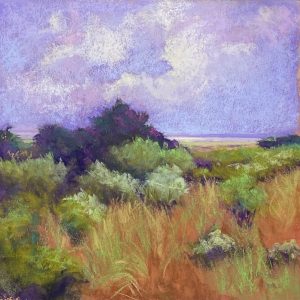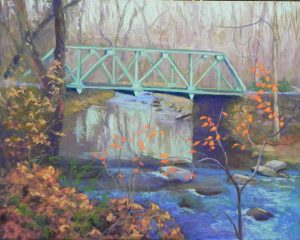
Montivideo Bridge, 16 x 20, UART 320 board
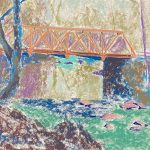
Underpainting, stage 1
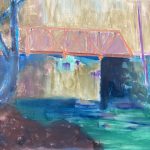
Underpainting, stage 2
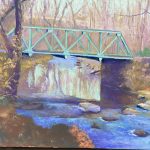
Painting in later stage
Hello Friends, I haven’t been very good at posting lately. I spent two weeks painting scenes from Scotland, then started teaching three classes on Mondays and Wednesdays. This last Monday, I did a demo for the class, which included very expericed to beginner artists! I chose a photo I took in 2017 and always wanted to paint. The one problem with it was that the entire photo was in a mid-value range, except for the area under the bridge, which was amost black. So very unbalanced and I knew I had to change that. Other than that, the changes were some simplification of the trees, bushes, etc.
The first problem of doing an underpainting, of course was the bridge. I had carefully drawn it in, with all the nice details. Then I realized that the background and bridge were the same in value so I lost most of the detail. But I got it back, thankfully–with the help of my students. Another issue was the background trees. I had planned to keep them very simple and initially brought the sky holes and trees down to the top of the bridge. After the demo, working on my own, I realized that this didn’t work at all! First, I added some yellow ochre just above the road level of the bridge, to indicate the top of the grasses that appear below. Then, I added in the line of a distant hill and background trees and made sure the sky didn’t come below them. Initially that hill line was almost parallel to the top of the bridge and this wasn’t good at all! (Everything going downhill!) So I tried making it opposite, with it lower on the left and higher on the right. Finally I got rid of it and very lightly indicated a horizontal line that is less noticeable but works OK. I couldn’t call it finished until I did that!
I faced the major problem of the dark underside of the bridge, by making the tree at left darker, using the same violets and browns that are in the bridge. And I connected the two with dark in the water. The area at left, while it looks complicated, was quite easy. I started with a dark underpainting, then added more dark pastels on over (mainly violet), then used various soft ochres and rusts for the leaves. (I kept them fairly dull so as not to compete with the leaves on the right.) This area really looked good when I added “water holes” in the area at bottom middle, to break up the hump and show the river behind the leaves. The “hump” was important to my composition as I didn’t want a strong diagonal in this corner.
The river has two distinct areas: the reflections in calm water in the back and the moving, darker passages of blues in the foreground, along with a lot of rocks! I used a variety of blues, violets, and blue greens, trying to indicate areas of reflection, shadow, and white water. In the back, I was careful to try to indicate trees above and reflections below.
The last addition was the small tree in the foreground with its lovely red orange leaves. In the photo, they were fairly light and when I tried a piece of color that matched, it didn’t look like anything. So I went to a darker and brighter red orange Schmincke and put in the leaves with small saturated strokes. I first put a lighter orange on top, and realized this was dull (it had white in it). I then went to an orange that had more yellow and this worked beautifully. Remember the power of yellow in saying “LIGHT”!
While this wasn’t an easy painting, it was something that was in my comfort zone. I knew I had a good composition and that I could fix the values and improve on the color. After working all summer on the prepared boards with or without photos, it was kind of a relief to me! But I’m not done. I plan to continue with the prepared surface and looser paintings. And I have five mounted boards left and am thinking of trying some fall trees on them that won’t be so realistic.
I’m also thinking of playing more with the Lux Archival. I recently did an imagined garden scene, based on a new garden here at Fox Hill. I started with watercolor and came up with a basic composition. Then added sedum, butterfly bush and zinnias (from another garden) to it. Here it is. You can see the difference between these picture pretty easily I think! I really had to make up almost everything in the one of the garden and I have no idea whether it’s any good or not. Would love to hear what you have to say.
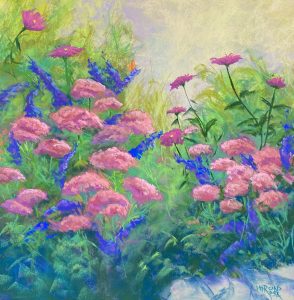
Fall Garden, 18 x 18, Lux Archival

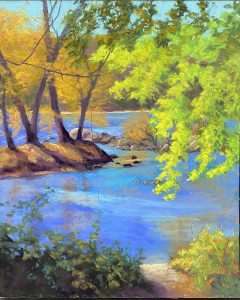
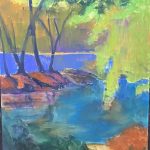
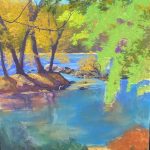
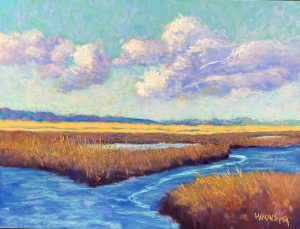
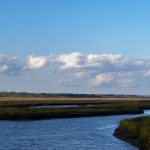
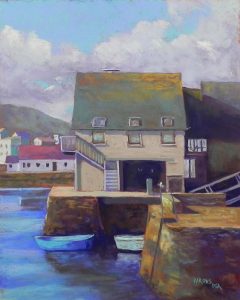
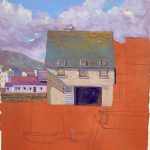





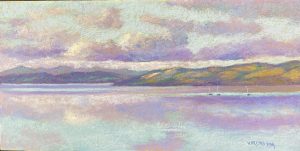
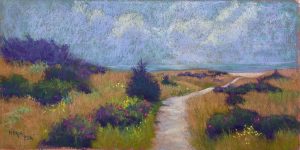
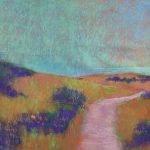
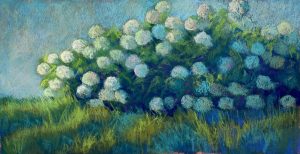
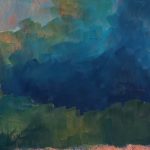
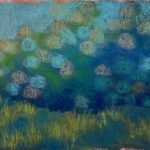
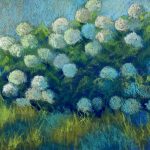
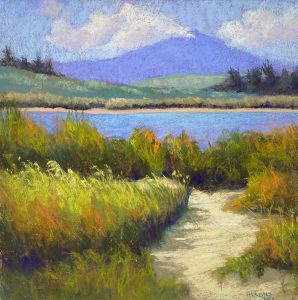
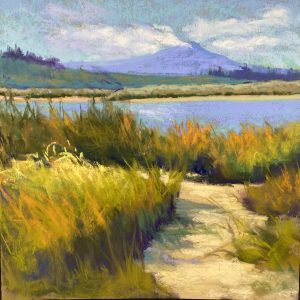
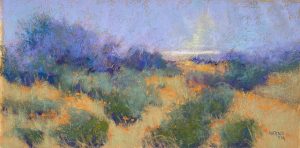
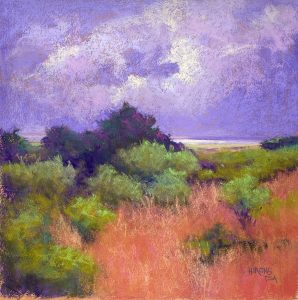
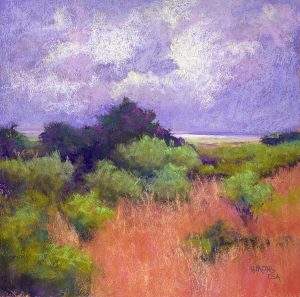 I’m back in the studio–just sold two of my studies! I also came to revise the painting after thinking about it more. When I came in, the painting was on the floor folded over! Well! I guess that told me something. Anyway, I have reworked it. There is now some aqua in the sky along with the violet, which I think gives it more dimension and softness. I added lighter colors to some of the bushes (which I had in a study) and I’ve changed the foreground grasses. I wiped off the reds and went back in with more sienna colors and added green and yellow grasses into that. It’s more detailed now and definitely less “abstract”! Not really abstract at all! I told my friend that perhaps I was “intuiting” the landscape as opposed to “abstracting” it. Anyway, I think it’s a better picture and I hae put glassine on it and I”m done with it for now. (Sorry the underlining showed up and I can’t find a way to get rid of it) Also, I realized that what I’ve been painting is Rehoboth, not Delaware Bay! The latter is much bigger!
I’m back in the studio–just sold two of my studies! I also came to revise the painting after thinking about it more. When I came in, the painting was on the floor folded over! Well! I guess that told me something. Anyway, I have reworked it. There is now some aqua in the sky along with the violet, which I think gives it more dimension and softness. I added lighter colors to some of the bushes (which I had in a study) and I’ve changed the foreground grasses. I wiped off the reds and went back in with more sienna colors and added green and yellow grasses into that. It’s more detailed now and definitely less “abstract”! Not really abstract at all! I told my friend that perhaps I was “intuiting” the landscape as opposed to “abstracting” it. Anyway, I think it’s a better picture and I hae put glassine on it and I”m done with it for now. (Sorry the underlining showed up and I can’t find a way to get rid of it) Also, I realized that what I’ve been painting is Rehoboth, not Delaware Bay! The latter is much bigger! 